What Happened on Palm Sunday? - Que Sucedio El Domingo De Ramos?
In the tapestry of human history, certain days stand out, etched into our collective memory not by the grandeur of empires or the clamor of war, but by the quiet resonance of profound events. Such a day is Palm Sunday, a day that whispers of humility and hope, of triumph and tragedy, all interwoven in a narrative that continues to resonate across millennia. But what exactly transpired on that pivotal day, a day known in Spanish-speaking communities as "Domingo de Ramos"? What echoes of that ancient story still reach us today, shaping our understanding of faith, sacrifice, and the human condition?
Palm Sunday, or "Domingo de Ramos," marks the beginning of Holy Week in the Christian calendar, a week of solemn observance culminating in the commemoration of Jesus' crucifixion and resurrection. It is a day rich in symbolism, drawing its name from the Gospel accounts of Jesus' triumphant entry into Jerusalem, where he was met by crowds waving palm branches, a traditional Jewish symbol of victory and peace. Their cries of "Hosanna!" - "Save us!" in Hebrew - filled the air, expressing their hope that Jesus, hailed as the Messiah, would liberate them from Roman rule.
However, the jubilant procession of Palm Sunday was not simply a political rally. It was a profound theological statement, a living tableau enacting the prophetic words of Zechariah 9:9: "Rejoice greatly, Daughter Zion! Shout, Daughter Jerusalem! See, your king comes to you, righteous and victorious, lowly and riding on a donkey, on a colt, the foal of a donkey." Jesus, by choosing to enter Jerusalem in such a humble manner, riding not a warhorse but a donkey, the animal of peace, was deliberately fulfilling this prophecy, revealing himself as the true king, not of earthly kingdoms, but of hearts transformed by love and compassion.
Yet, within this scene of triumph, a shadow lurks. The same crowds who hailed Jesus as king on Palm Sunday would, just days later, demand his crucifixion. The palm branches laid at his feet would become a poignant reminder of the fickleness of human loyalty, the swiftness with which adoration can turn to condemnation. This stark contrast underscores the complex and often paradoxical nature of Jesus' mission, a mission rooted not in worldly power, but in selfless love, a love that extended even to those who would betray and crucify him.
Palm Sunday, therefore, stands as a powerful reminder of the dual nature of our human experience - the capacity for both great love and profound cruelty, for unwavering faith and crippling doubt. It is a day that calls us to reflect on our own capacity for both, to examine the motivations of our hearts, and to choose, even in the face of uncertainty and fear, the path of compassion, forgiveness, and unwavering love, the very path Jesus modeled for us on that first Palm Sunday.
While specific details like "best practices" or a "checklist" don't apply to a historical and theological event like Palm Sunday, exploring resources such as biblical commentaries, theological texts, or even historical analyses of the period can provide deeper insights into the significance of Palm Sunday. Engaging in personal reflection, prayer, or participating in religious services commemorating Palm Sunday can further enrich one's understanding and experience of this impactful occasion.
Arm tattoos for men a canvas of masculine expression brazo tatuajes para hombres
Tiktoks hilarious hip dance craze a deep dive
Finding faith and community your guide to catholic churches in roseville














